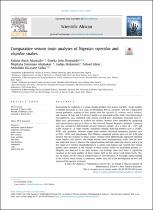| dc.contributor.author | Adamude, Fatima Amin | |
| dc.contributor.author | Dingwoke, Emeka John | |
| dc.contributor.author | Klein, Ashwil | |
| dc.date.accessioned | 2023-04-24T09:25:28Z | |
| dc.date.available | 2023-04-24T09:25:28Z | |
| dc.date.issued | 2023 | |
| dc.identifier.citation | Adamude, F. A. et al. (2023). Comparative venom toxin analyses of Nigerian viperidae and elapidae snakes. Scientific African, 20, e01622. https://doi.org/10.1016/j.sciaf.2023.e01622 | en_US |
| dc.identifier.issn | 2468-2276 | |
| dc.identifier.uri | https://doi.org/10.1016/j.sciaf.2023.e01622 | |
| dc.identifier.uri | http://hdl.handle.net/10566/8869 | |
| dc.description.abstract | Envenoming by snakebite is a serious health problem that maims and kills a large number of people, primarily in rural areas of developing African countries. The first comparative venom proteomic analyses of four snakes from the viperidae (E. ocellatus and B. arietans) and elapidae (N. haje and N. katiensis) families are presented in this study. Two-dimensional electrophoresis was combined with matrix-assisted laser desorption ionization time-of-flight mass spectrometry to analyze the venoms. Proteins were identified by comparing mass spectrometry spectra to those in the reviewed Uniprot-Serpentes database. A protein spot was considered differentially present between samples at a p-value of < 0.05 and a fold change of >2. Viper venoms contained cytotoxic-inducing proteins such as SVMPs, SVSPs, and cytotoxins, whereas elapid snake venoms contained neurotoxic proteins such as PLA2, 3-FTx, and neurotoxins. | en_US |
| dc.language.iso | en | en_US |
| dc.publisher | Elsevier | en_US |
| dc.subject | Proteomics | en_US |
| dc.subject | Snake venom | en_US |
| dc.subject | Biotechnology | en_US |
| dc.subject | Reptile | en_US |
| dc.subject | Nigeria | en_US |
| dc.title | Comparative venom toxin analyses of Nigerian viperidae and elapidae snakes | en_US |
| dc.type | Article | en_US |

